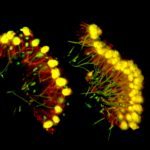Link to Pubmed [PMID] – 24281726
Link to DOI – 282110.1038/ncomms3821
Nat Commun 2013 ; 4(): 2821
The modulation of developmental biochemical pathways by mechanical cues is an emerging feature of animal development, but its evolutionary origins have not been explored. Here we show that a common mechanosensitive pathway involving β-catenin specifies early mesodermal identity at gastrulation in zebrafish and Drosophila. Mechanical strains developed by zebrafish epiboly and Drosophila mesoderm invagination trigger the phosphorylation of β-catenin-tyrosine-667. This leads to the release of β-catenin into the cytoplasm and nucleus, where it triggers and maintains, respectively, the expression of zebrafish brachyury orthologue notail and of Drosophila Twist, both crucial transcription factors for early mesoderm identity. The role of the β-catenin mechanosensitive pathway in mesoderm identity has been conserved over the large evolutionary distance separating zebrafish and Drosophila. This suggests mesoderm mechanical induction dating back to at least the last bilaterian common ancestor more than 570 million years ago, the period during which mesoderm is thought to have emerged.

